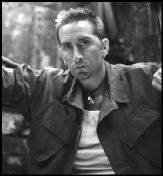DJ MICRO
Showbox, 628-3151, $15 adv.
10 p.m. Fri., July 26
House music started out as a trashy little tramp of a thing. Its early hits built on little more than a drum machine pumping away at headboard-against-the-wall tempo and a few breathy pleas to jack your body into the orgiastic confluence of dancers on the floor. House was populist and it was lowbrow, unashamedly less complex than even its predecessor, disco.
At least that’s the house music a 13-year-old Chicago kid who would become Bad Boy Bill heard on his radio. In the two decades since its birth in the Windy City’s black gay underground, house has gotten a 9-to-5 job, traded its sweat-stained T-shirt for a sharp monochromatic suit, and stopped hooking up with strangers in the bathroom. Witness the house flavor du jour: the deep, frictionless sound served up by of-the-moment label Naked Music, where all the rough edges have been rounded off and watery melodies soothe listeners into a Zoloft-like haze.
For his part, Bad Boy Bill says this kinder, gentler phase of the music is fine “for lying back at the bar talking to friends,” but it’s still the less-mannered, old-school strain that ignites his passion. “My style is a lot more peak house,” the veteran DJ explains over the phone from Chicago. “I tend to play the sweatier, go-nuts style of house.”
And he plays it in a much sweatier, go-nuts way than the newer crop of house selectors, who put a premium on extended, seamless mixes between records. Bill, on the other hand, slashes back and forth with the crossfader, indiscreetly dropping in chunks of sound. He bobs and weaves between the turntables and his record crate as he fiddles with the mixer knobs and scribble scratches into the next track.
His aggressive, trick-heavy approach has its origins in the music’s earliest beginnings as well. Too young to get into the clubs, Bill would tune in to WBMX, one of the only commercial stations in the history of American radio to really support underground dance music. The jocks who held court at WBMX were the dexterous Hot Mix 5 tag team. Bill would listen in and guess at what turntable techniques they were using, trying to replicate them in his bedroom.
“What was so special about the Hot Mix guys was that each of the five DJs had his own unique style,” he says. “[Hot Mix member] Farley “Jackmaster” Funk was more deep house, but with cutting and scratching; Mickey Oliver had more of a European, NRG sound—but they would all meet on certain big records. So the hottest track of the moment might appear in three of the five mixes, but each would use it in a different context.”
Bill wanted a piece of the action, so he started throwing parties at rented halls and hiring the Hot Mix 5 to spin at them. He struck up a friendship with Farley “Jackmaster” Funk, who soon after decided to jump ship from WBMX and start his own all-star DJ fivesome at a competing station. Funk hired Bill for his team and pushed him to be especially flashy on the decks, hungry as he was to snatch ratings.
By the late ’80s, house’s wave had crested in Chicago—the radio shows were yanked and healthy numbers of records were selling only in Europe. After a couple years’ incubation period overseas, the music came back to the States as fodder for the main-room sound systems in the burgeoning rave movement.
Bill, who in the meantime had honed his skills enough to take second place at the 1988 U.S. finals of the DMC DJ competitions, embraced the rave circuit more than any of his hometown contemporaries. The combination of his taste in tracks, which ran toward the hornier, harder side of house, and his frenetic b-boy showmanship proved irresistible to the amphetamine-charged kiddies in the massive warehouse scene.
However, Bill’s constant touring meant his own production and remix work would be released only sporadically and relatively late in his career. After more than 15 years as a DJ, he’s yet to submit a complete artist album (although he has one slated for 2003), promoting himself instead with a successful five-volume series of mix CDs called Bangin’ the Box. Without a full-length of his original material—something considered a crucial milestone in the dance press—Bill has achieved near superstar status without the aid of magazine covers or much promotional muscle.
“I’ve always tried to promote myself to the people,” he says. “If people were buying the mix CDs and coming to the shows, then I was happy and didn’t feel the need to push it harder than that.”
Throwing a few skanky house classics into the mix, it seems, has a way of speaking for itself.





